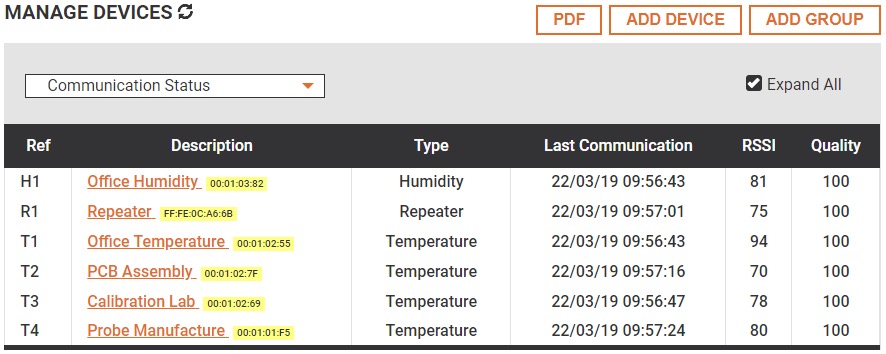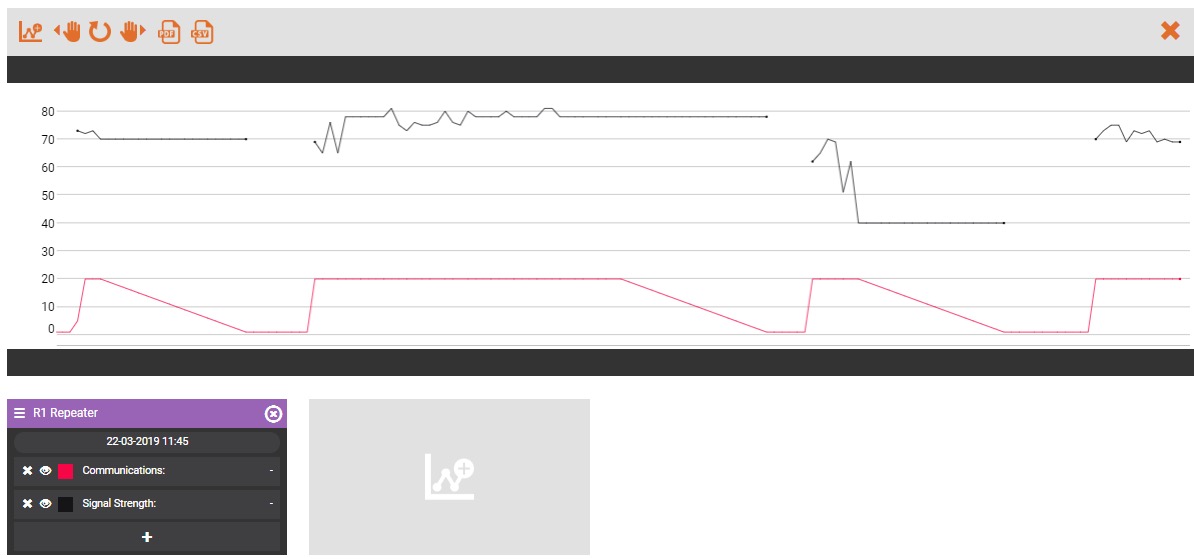 Loss of Wireless Communications
Loss of Wireless Communications
The key to any wireless system is the communication between the wireless transmitters and the base station.
We use a bi-directional communication protocol; this means that if communications fail the system can alert users.
Common Caused of Communication Failure
The most common causes of communication failure are:
- Repeaters are turned off.
- The transmitter is on the edge of its communication range and occasionally drops out.
- A change in the environment conditions, i.e., things have moved around in the building/new machinery installed, etc.
- Very rare, but must be considered, the transmitter or sensor may have failed.
STEP 1 – Checking Repeater & Sensor Communication Status

How to check the communication status:
SETTINGS => SENSOR ADMINISTRATION => MANAGE DEVICES => Select Communication Status from the drop-down menu.
The screen shows the communication status for each device. Shown is the last time the device communicated, the current RSSI and signal quality.
Repeaters
If the RSSI & quality are blank, then this indicates the repeater is not communicating.
The most likely cause being the repeater is switched off. Locate the repeater and check it’s powered on; if off switch on, then wait for its communication to resume.
When first switched on, or when not able to communicate, the repeater will constantly display 3 long flashes. Once communication is established these will stop, the repeater will occasional flash quickly as it sends data for sensors.
If switched on and
No lights appear when the repeater buttons is pressed,
- Check: the power socket is operational; move the repeater to another power point, does it work there?
- If power is working it indicates a fault with the repeater or power supply, contact your system supplier for support.
If, when the button is pressed the repeater flashes once very quickly then it has not been correctly logged onto the system, re-log the repeater. See Logging a Repeater.
If on, with the RSSI & quality low, indicates that the repeater is at the edge of its communication range. Moving the repeater closer to the base station will improve its communications.
Low for RSSI is below 40 & quality below 50.
Check for communications breaks, see Step 2 below.
Transmitter
If the RSSI and Quality are blank, then the transmitter is not communicating. See Steps 3 & 4 below.
If both numbers are low, it may be that the transmitter is at the edge of its communications range and a repeater may be required.
Check for communications breaks, see Step 2 below.
STEP 2 – Check for Communications Breaks

Signal communication breaks indicate that the transmitter & sensor or repeater are on the edge of their communication limit. Additional repeaters are required to ensure continuous signal.
Use the graphing tool to view signal and communication breaks, to access the graphing tool:
SITE => select the graph icon in front of sensor in question. For repeaters select the Sensor Type drop down and then select the relevant repeater graph icon.
Once the graphing tool loads select a date range, this can be over a week or month.
On the graph.
- Add the Communication and Signal Strength readings. Select the + button and click on both options.
- Other information like High and Low set points can be removed.
Communication drops and breaks in the Signal Strength line show intermittent communication breaks are occurring. An additional repeater added to the system will assist in resolving these issues.
However, check Step 3 before added the repeater to ensure other factors are not the issue.
STEP 3 – Changes in Environment
Changes like:
- Large objects being placed in-front of a transmitter/repeater.
- A sensor being moved, or new plant/walls installed.
- Other changes in the location of the transmitter/repeater.
It is good practice to check the transmitters and repeaters are still in their correct locations and that nothing has been placed in front of them.
By simply moving the transmitter or repeater communications performance may be improved.
STEP 4 – Check the Transmitter & Sensor are Operational
Transmitters
The transmitter has a button on the front that enacts forced communication.
When pressed this button will enact the transmitter LED in one of 4 ways, these are:
- No LED flash, indicates that the transmitter is not working, contact your supplier for assistance.
- Very quick single flash: indicates that the transmitter has not been correctly paired with the base station (see Pairing a Sensor).
- One long flash; the transmitter is trying to send data, but the base station is not responding (i.e. the base station is not receiving the data). Move the transmitter closer to the base station. If then 2 flashes are seen the sensor is working. If only 1 flash, then see sensor information below.
- Two longer flashes – the transmitter has sent data and the base station has received it and responded. The transmitter is operational and working.
If 3 & 4 above are experienced and gaps are seen in communications, then an additional repeater is the solution to improve system communications.
Sensors
Communication errors on the DS-300 range of sensor can be due to the sensor not communicating with the base station.
The causes of this could be the sensor and transmitter are out of range (as covered above) or the sensor has a fault.
Detecting a sensor fault through the alarm review;
Review the sensor details in the alarms historical review; ALARMS -> HISTORICAL -> Show last 250 alarms and enter sensor number in the search bar.
The sensor will go into a fault state prior to the communication alarm. This indicates that the sensor is faulty and causing the communications issue.
Detecting a sensor fault at the transmitter;
- If a transmitter has a single flash when the button is pressed, remove the sensor and press again. A double flash will indicate that the sensor may have a fault, repeat 3 to 4 times. With single flash with the sensor attached and double with it removed, the contact your system supplier for support.
- If the transmitter is less than 2 years old, and the battery is dead/depleted this indicates that to much current is being drawn. This may be a fault in either the transmitter or sensor, contact your system supplier for support.
